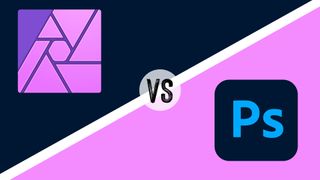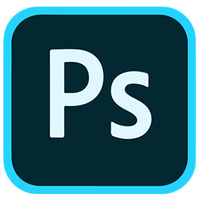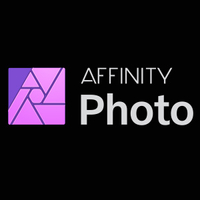Affinity Photo vs Photoshop – it's the battle of the two best image editing programs around. On a market that's awash with image editing software for creatives, choosing the best option for your needs is becoming increasingly difficult, but the main competition comes down to these competing programs: Adobe Photoshop and Affinity Photo. Here we put them head-to-head in a battle for supremacy.
First, a bit of history on Affinity Photo vs Photoshop. Adobe's Photoshop was developed by Thomas and John Knoll in 1987 and was sold to Adobe Systems Inc in 1988. It was the first image editing software to be made available to the public and it's maintained its dominance as the industry-leading image-editing software ever since. Affinity Photo is much newer, developed by Serif in 2009 and launched in 2015. But since then, it's firmly cemented itself as a compelling alternative to Photoshop, offering many of the same tools and features for adjusting and manipulating images, as well as tools for design.
The two programs are extremely similar in many ways, but their pricing structures are completely different. Affinity Photo is popular for its perpetual licence, whereas Photoshop uses a subscription model that makes it significantly more expensive. In this article, we’ll look at how the two programs compare in several areas to help you to decide which is best for you. For more options, see our guide to the best photo-editing software, and make sure you also check out our guide to the best laptops for photo editing.
Affinity Photo vs Photoshop: Features and tools

Starting out with the user interface, Affinity Photo and Photoshop look extremely similar. They both have a main menu running along the top, an Options Bar providing different options depending on the tool selected, a tool panel on the left, a document window in the centre and a series of panels on the right.

Photoshop undoubtedly has the edge over Affinity Photo with more tools, features and functionality for performing a range of advanced editing tasks. These include AI-powered tools, more Layer controls, masking options, 3D image creation and video support to name but a few. That said, Affinity Photo can keep up with Photoshop in most areas when it comes to standard image editing and it excels in certain areas. For instance, it’s much easier to perform tasks such as focus stacking, noise stacking and other stacking-based techniques in Affinity Photo since they're initiated via the main menu rather than applied in a more complicated way. See our full Affinity Photo review for more details.
Affinity Photo vs Photoshop: Raw editing

Both software options offer Raw editing. Affinity Photo has fantastic tools for processing but bulk processing is tedious. In Photoshop, this isn’t a problem thanks to a more intuitive workflow overall, although it is slightly more complicated to use. You also get Lightroom and Lightroom Classic if you take our Adobe's Photography Plan, and these offer image cataloguing, Raw image processing and much more.
Affinity Photo vs Photoshop: Compatibility

Photoshop offers the most compatibility overall. Its native PSD files are compatible with many more software programs than Affinity Photo’s native file format .afphoto, which isn’t compatible with many, if any, other editing programs.
In many ways, TIFFs are a superior file format to both PSD and afphoto files for several reasons, but when sharing files between Affinity Photo and Photoshop, PSDs are by far the most compatible and sharing TIFFs between the two isn’t recommended.
When you Save As in Affinity Photo you’re presented with one option, and that’s to save images in the software’s native .afphoto file format. Although you can export images in a variety of other formats and work with these instead if you prefer. Photoshop, on the other hand, has no preference for saving in a particular file type so you can select the desired type with Save As without the need to export.
Another area where Affinity Photo works well is with Photoshop Plugins. Many are compatible with both programs, but Affinity Photo does require a more protracted process for installation. And if you’re a fan of keyboard shortcuts, you’ll find that Affinity Photo has adopted many of Photoshop’s shortcuts so transitioning from one to the other can be almost seamless in this respect.
Affinity Photo vs Photoshop: Learning curve/usability
There’s no getting around the fact that both Affinity Photo and Photoshop are complex and feature-packed, which inevitably means there’s a fairly steep learning curve when learning how to use either. Photoshop also includes the ability to work on 3D files and even video, both of which require additional learning and knowledge to achieve the best results.
There are many books, magazines, online resources and even workshops available that will help you get to grips with both software options. You can choose the best learning method for you and improve your skills quickly whichever option you choose. Affinity Photo is, however, arguably the easier of the two to learn because it’s not quite as cavernous as Photoshop and it's presented in a less intimidating way as a result.
Affinity Photo vs Photoshop: system requirements
When it comes to comparing Affinity Photo vs Photoshop in terms of system requirements for Adobe's Photoshop is more demanding, requiring more RAM, more storage and more recent OS. Scroll to the bottom of our comparison to see a full breakdown of requirements.
Affinity Photo vs Photoshop: Price

Affinity Photo and Photoshop use different pricing structures. The former changes just a single payment that gives you a perpetual licence. Photoshop, however, uses a more expensive subscription-based model. This key difference could be a deciding factor for enthusiast photographers and designers, although for professionals paying a subscription for feature-packed, industry-leading software is less likely to be an issue.
An Adobe Creative Cloud Photography Plan is a subscription-based software package for Mac and Windows that costs $119.88 / £119.21 yearly and can be paid upfront or for a monthly fee of $9.99 / £9.98. With the subscription, you get 20GB of cloud storage alongside access to Photoshop, Bridge, Lightroom and Lightroom Classic, giving you a complete photo editing workflow, which Affinity Photo doesn’t provide. The other benefit of a subscription is that you'll always get automatic access to updates to the software.
Affinity Photo is available with a perpetual license for $54.99 / £47.99 on Mac and Windows or $21.99 / £19.49 for the touch-controlled iPad version. This means you pay a one-off fee and receive software updates for the duration of the current version (V1). And when version cycles last for years, this represents incredible value for money. When the second version (V2) is released, users will be able to continue to use V1 or to upgrade to V2 for an upgrade fee.
Affinity Photo vs Photoshop: Conclusion
Choosing between Affinity Photo and Photoshop probably won’t be an issue for professional creatives because, despite the higher subscription cost of Photoshop, the additional tools and functionality on offer, alongside the intuitive workflow will be well worth the extra cost. And that’s before we even consider the additional useful software, including Lightroom and Lightroom Classic, that are bundled in the Creative Cloud Photography Plan.
Where a decision between the two becomes trickier, however, is for enthusiast/hobbyist creatives. The subscription model used by Adobe is expensive, and paying just $54.99 / £47.99 for years of software use is an attractive proposition. Especially when you consider that Affinity Photo offers the tools and features required for standard photo editing and manipulation at this level. Not to mention, it’s arguably easier to learn how to use than Photoshop. Both programs are available as free trials, so it’s worth trying both to be completely sure of which is best for you.
What the the system requirements for Adobe Photoshop?
In our comparison of Affinity Photo vs Photoshop, the latter is the heavier program with the more demanding hardware requirements. These are the specs you'll need to run the software.
Mac
OS: macOS Catalina (version 10.15) or later
Processor: Intel processor with 64-bit support, 2 GHz or faster processor with SSE 4.2 or later
RAM: 8GB
Graphics: GPU with Metal support and 1.5 GB of GPU memory
Storage: 4GB of available hard drive space
Display: 1280x800 or better
Windows
OS: Windows 10 64-bit (version 1909) or later
Processor: Intel or AMD processor with 64-bit support (2 GHz or faster processor with SSE 4.2 or later)
RAM: 8GB
Graphics: GPU with DirectX 12 support and 1.5 GB of GPU memory
Storage: 4GB of available hard drive space
Display: 1280x800 or better
iPad
OS: iPadOS (14.0). Compatible with Pad Pro (all models), iPad 5th generation or newer, iPad Air 2 or newer, iPad mini 4 or newer.
What the the system requirements for Affinity Photo?
The system requirements for Affinity Photo are less demanding than those for Photoshop. These are the specs you'll need depending on what device you want to run it on.
Mac
OS: 10.9 Mavericks or later
Processor: M1/M1 Pro/M1 Max chip or Intel
RAM: 2GB minimum
Storage: Up to 2.8GB of available hard drive space
Display: 1280x768 display or better
Windows
OS: Windows 7 64-bit (Service Pack 1, Platform Update KB2670838, Aero enabled) or later
Graphics: DirectX 10-compatible Graphics Cards and above
RAM: 2GB
Storage: 953MB of available hard drive space
Display: 1280x768 display or better
iPad
OS: iOS 12 or above. Compatible with iPad Pro (all models), iPad Air (2, 3 & 4), iPad (2017 onwards) and iPad Mini (5 & 6)
Read more:
- Lightroom vs Photoshop: which is best?
- Photoshop tutorials: excellent lessons to advance your skills
- The best video editing software




